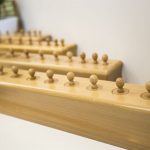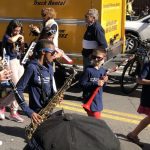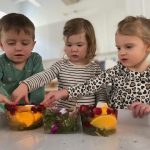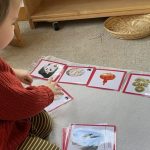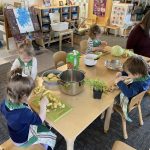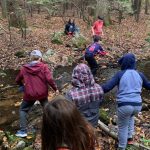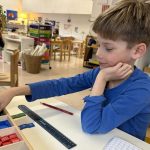Elementary Program (6 – 12 years old)
Lower Elementary – 6 – 9 years old
Upper Elementary – 9 – 12 years old
Elementary Scheduling Options
Program Hours: approximately 8:15am-3:15pm
After-School Care: 3:15pm – 6:00pm
School Year: August – June
After-School Activities are available seasonally based on availability.
Lower Elementary
The Elementary lessons and materials are multi-sensory, dramatic, and impressionistic, serving to ignite the imagination and curiosity of the students.
First through third grade
This age is characterized by heightened social awareness, imagination, and a sense of morality. Younger children are inspired by the big work of their older peers. The focus is not on forcing the child to memorize facts, but rather to understand concepts and learn how to learn. The elementary classroom supports children’s independence and potential by inviting them to engage in an expansive course of study. The Elementary years signify stable physical growth and heightened curiosity. Dr. Montessori calls these the “years of plenty” for children because of their mental capabilities. Lower Elementary students ages 6 to 9 follow a 3-year cycle, combining rigorous academics with enriching activities, mirroring the real world. Like adults, students learn to balance work time and free time, socialize, and tackle challenges to build on their strengths.
The Elementary Curriculum
Elementary-age students are naturally curious and have a strong internal drive to discover how our world works. Montessori’s Great Lessons, presented every year, provide a starting point for any course of study. For example, the Great Lesson referred to as “The Birth of the Universe” incorporates astronomy, physics, chemistry, earth science, and geography. Using illustrations, scientific demonstrations, and storytelling, the Great Lessons touch on the natural world, as well as the world of humankind in history. They are designed to spark the child’s imagination and to provide a context for all further study. Meaningful learning happens when children are inspired by a lesson and begin to explore the subject and work on their own.
Children may ask, “How does a fish breathe under water?” “What number comes after a trillion?” “What causes a volcano to erupt?” Montessori guides encourage children to find out! Montessori students are empowered to find the answers to their own questions with the materials and resources in a prepared environment. Children enjoy learning that is driven by their passions.
Individualized Learning
Children in Montessori have significantly more input into how they are taught, and control over how they learn, than children in traditional school settings. Their natural learning styles and preferences are respected and supported. The trained Montessori Elementary teachers keep thorough notes of which lessons the child has received and which they still need. Montessori students are empowered to advocate for their learning and ask questions.
Cross-curricular Research
Each child’s response to a lesson is unique, and their follow-up work reflects those individual differences. For example, when the Elementary Guide gives a lesson on the Timeline of Life, some children will be especially inspired by this. Some may choose to study invertebrates, while others will want to learn more about dinosaurs, how mass extinctions occur, how plants reproduce, or how a volcano erupts. Some may wish to present their research to the class or a small group of children. The research integrates other skills, such as reading, writing, speaking, and listening in a meaningful context.
Collaboration and Cooperation
Elementary children have a strong drive to be social and to collaborate. For this reason, many of the lessons and follow-up projects in elementary are done in pairs or groups of children. Each day, students practice the social skills necessary to plan and carry out projects: delegation and division of labor, sharing resources, making group decisions, taking responsibility for actions, and celebrating the success of peers. Conflict is not uncommon. It is a necessary and important part of the student’s work. The motivation to resolve the conflict comes from the children and their engagement with their projects. The Montessori Teacher models and supports constructive and respectful problem-solving. This social-emotional work is ongoing on constant in the Elementary classroom.
Students are empowered to seek knowledge beyond the classroom
Going Outs are a big part of the Elementary classroom. These are opportunities for students to venture out of the classroom to gain experience and information in order to deepen their study for a particular project. The students are responsible for scheduling the outing and arranging for their own transportation and supervision (by staff or parent volunteers), and then return to share their research with the rest of the class. In addition to its academic value, each Going Out is an entire course of study on independence, life skills, responsibility, and good citizenship.
Upper Elementary
The Passage to Abstraction – Moving from Concrete to Abstract
Students in Upper Elementary are capable of more abstract thought, including the ability to think hypothetically. This also continues to be a time of great moral development. More than only concerned with right and wrong, good and bad, the Montessori Upper Elementary student now seeks to understand the motivation behind behavior and to develop possible solutions.
In addition, Upper Elementary is a time when students cross the bridge from using hands-on, manipulative materials to acquiring a fully abstract understanding of concepts. Whereas the student in Lower Elementary has been using three or four pieces of material to compute multiplication problems, the older student transitions to paper and pencil.
Upper Elementary students are encouraged to think for themselves, to explore different methods of problem-solving and to discover connections across areas of study. There is also a growing emphasis on developing real-world skills like time management, conflict resolution and collaboration.
The Upper Elementary Program builds on the content of the Lower Elementary global curriculum, expanding students’ awareness of their place in society and the world’s history. The three-hour uninterrupted work period continues to be a cornerstone of the philosophy, allowing students to dive deeply into work and develop intense concentration. Students continue to work collaboratively, inspiring and supporting one another in their work.
In their sixth year, Elementary students embark on a year-long activity known as Senior Project. Here, they integrate the research skills that they have acquired throughout their Elementary years. Students first write a research paper on a topic of personal interest and then give a presentation on that topic to the entire school community.
Students are supported in assessing their own progress
Upper Elementary students continue to explore their own interests through self-chosen work with minimal interruption. At the same time, students collaborate with their teachers to ensure that they are mastering the skills in each area of the curriculum. Because students of this age are interested in belonging to the society of their peers, they are internally motivated to meet (and exceed) national and state standards. Time management, organization, and setting reasonable, responsible goals are a priority at this level.
Students exercise leadership skills
The Upper Elementary student specializes in leadership. Students develop their leadership skills in the classroom and in the community. Students develop their own community service projects, fundraising efforts, and opportunities to mentor younger children.
Elementary Curriculum
Language and literacy for both communication and pleasure are key components of the Elementary curriculum. Students are encouraged to pursue their reading interests and to diversify their reading territories by means of guided, shared, and independent reading, as well as teacher read-alouds. Reading groups meet regularly, offering students the opportunity to practice reading for both comprehension and fluency. Through discussions, students expand vocabulary and develop strategies for inferring, analysis, and responding to interpretive questions. These conversations allow students to practice supporting their opinions with evidence from the text and to share and appreciate different perspectives.
Students express themselves through a variety of writing styles, including research reports, personal narratives, memoir, persuasive essay, and poetry. The writing workshop model allows students to choose and shape their own topics while also learning to clarify and enliven their work. The study of grammar, which begins soon after the student learns to read and write, continues through elementary. Students learn all parts of speech, explore sentence structure through diagrams, and carry out a special study of verbs. Cursive writing continues from primary into elementary, when word processing is introduced. Elementary children use several phonics-based spelling programs, including Words Their Way.
Elementary students continue to use concrete, multi-sensory Montessori materials to develop number sense and computational skills. Hands-on work, using a clear and reliable coding system enables students to explore increasingly complex math concepts. Through practice and articulation of problem and process, they construct solid math reasoning skills and become confident problem-solvers. Over the six years in Elementary, students also navigate a rich hands-on geometry curriculum, which begins with a study of nomenclature and shape and evolves into an application of mathematical skills to measure size–perimeter, area and volume.
Lower Elementary 1-3 Mathematics Program
Numeration: Establish place values from units to millions; form, read and compare single and multi-digit whole numbers; form, read, and compare fractions
Mathematical Operations: Add, multiply, subtract and divide whole numbers
Math Facts: Research of math fact combinations; develop fluency with math facts
Geometry: Name and classify lines, angles, polygons and closed figures; establish congruence, similarity and equivalence
Application: Use operations for word problems, to calculate with money, and other real world scenarios
Measurement: Use non-standard and US Customary measurement for length, mass, and temperature
Data: Collect, represent and interpret data using tally marks, bar graphs, line graphs and pie graphs
Pre-Algebra: exploration of the commutative, associative and distributive properties, analysis of squares and cubes
Upper Elementary 4-6 Mathematics Program:
Numeration: Form, read and compare whole numbers, fractions, decimals, and relative numbers; express numbers in standard, expanded and exponential notation
Mathematical Operations: Addition, multiplication, subtraction and division of whole numbers, fractions, decimal fractions and relative numbers; derivation of square and cube roots; application of order of operations
Geometry: Classification and measurement of lines, angles, plane figures and solids; determination of equivalence using multi-step proofs and application of the transitive property; use of a coordinate plane to plot points and lines; explorations of the Pythagorean Theorem
Measurement: Use metric units to measure length, area, volume and mass
Data: Collect, represent and analyze data using bar graphs, line graphs, and pie charts. Identify mean, median, mode and range of a data set. Determine probability to describe and predict outcomes
Proportionality: Use ratios, proportions, and percentages to express mathematical relationships; move flexibly between fractions, decimals, and percents to suit the scenario
Pre-algebra: Use variables to represent unknown quantities; expand and build polynomial squares; use tables, rules, variables and graphs to describe patterns and numerical relationships; derive formulas to generalize from specifics
Biology
For Lower Elementary students, the focus of science is on living systems. They begin their study by observing live plants and animals to notice their external parts and body functions. Using a question and answer research format, they discover similarities and differences among animals and plant species. This leads them to understand how scientists have grouped related species within the kingdom of life. Students focus on the five classes of vertebrates and the invertebrate phyla, as well as the plant kingdom. Through these studies, students refine their understanding of a life cycle and investigate how environmental alterations affect living systems. In addition to a more in-depth study of plant and animal physiology, Upper Elementary students study microbiology and human biology and health.
Earth Science
Throughout the six year Earth science curriculum, students learn about the relationship between the Sun and the Earth and the systems that shape the planet. These include study of the lithosphere, hydrosphere, atmosphere, weather systems and biogeochemical cycles. Involving students in environmental stewardship is the ultimate aim of these lessons, which are revised regularly to reflect the most updated data on the climate and the impact humans have upon their home planet. Action, in addition to knowledge, is an essential outcome of their work, and CMS students apply their understandings of Earth systems to solve real world problems.
Physical Science
Lower Elementary students begin their exploration of the physical world with a study of the nature of the matter, specifically the properties of solids, liquids, and gases. In related physical science lessons, students study light, heat, and sound. Upper Elementary science topics include the study of star life-cycles, the periodic table of elements and atomic structure, mechanics, and electricity. Student lab work is built around the scientific method and the engineering design process.
Elementary students, armed with great imaginations and deep curiosity, are excellent time travelers. They enjoy the “great lessons,” which invite them to contemplate long ago events: the birth of the Universe, the formation of the planet Earth, the coming of life, the origin of writing, and the history of numbers. The tools they need to build a timeline of human history are presented early and nurtured throughout the Elementary years. Using a variety of clocks, timelines and matrices, students learn how to organize events over big and small lengths of time. As an introduction to history research, students use a fundamental human needs framework to learn how all people, both ancient and modern, have met their physical and spiritual needs. This allows students to recognize the unifying traits of humans of all places and all times, while also appreciating their rich cultural differences.
In the Upper Elementary years, students examine human progress more closely through studies of early human cultures, the rise of civilization, and American history. In addition to the fundamental needs framework, students brainstorm and categorize their own research questions to examine the geography, daily lives, culture, and political and economic systems of both ancient and modern cultures. Research projects become more extensive and include written reports, presentations and collaborative projects to showcase their findings. The organization of the history curriculum over three years enables students to build valuable historical perspective and to learn from the past.
Elementary students are naturally keen to develop a geographic perspective and explore their place on the planet. They use a series of physical, political, and biome maps to strengthen knowledge of natural and manmade geography, as well as to chart trends in population and migration. The study of resources begins with an examination of the crucial role of agriculture. Through role play, creation of product maps and study of products, students learn how the things around them are a result of cooperation and agreement among people and the elements. Older students look critically at the distribution of resources around the world, global trade, and how economics impacts the way people live and work.
Lower Elementary students have basic library orientation sessions followed by frequent opportunities to visit the library to find materials for their classroom research and independent reading. Third graders work specifically with library skills, including the library structure and research skills. The Lower Elementary classrooms each have two desktop computers and two Chromebooks. Students demonstrate beginning steps in using available hardware and applications, and they use various age-appropriate technologies to locate, collect, and organize information.
Upper Elementary students engage in more advanced library skills work, especially in the context of research. An emphasis is also placed on continued development of personal reading interests, both fiction and non-fiction. Students have increasing access to computers from fourth through sixth grade as the develop increasing independence in their range of studies, culminating in their Senior Project, a capstone research and presentation experience.
Elementary students engage in building practical skills such as cooking, managing their materials and time, and organizing activities. Each student is accountable for completing class work in the time allotted and confers with teachers weekly to track progress. As children move forward, they are given increasing responsibility in planning and executing their weekly tasks, including cleaning and managing belongings. In Upper Elementary, students’ practical life lessons include technology, and they learn and practice on-line research, keyboarding, email, and internet safety.
The peaceful resolution of conflicts continues to be a goal in the Elementary classroom. The older the students become, the better they are able to resolve disputes on their own. Teachers are available to facilitate discussions between students, but props like a “talking stone” can aid students in resolving conflicts independently. Acting with grace and courtesy toward others is modeled by the adults, and courteous behavior and consideration for others is expected of Elementary students. Children can help one another remember to use polite language and that their actions affect others. Elementary students participate in a number of community service efforts over the course of the year, including Service Afternoon in the spring when we make cards and pot plants to give to our neighbors. Students also tie-dye shirts to be used in the Boston Pride March, and pick-up trash in neighboring Danehy Park, as well as take part in a canned food drive.
Lower Elementary students continue their exploration of the Spanish language through topics that integrate their classroom studies and personal experiences. Greetings, expressions of courtesy, simple dialogue, playful rhymes, and songs complement their work in basic reading and writing in Spanish.
Upper Elementary students are introduced to grammar concepts, which help to expand their ability to read, write, listen, and speak in Spanish. Over the course of the year, the rich diversity of Spanish-speaking cultures is explored through authentic literary and audio-visual sources, music, and projects. Vocabulary is reinforced and expanded through word games and role play.
Art classes meet once a week in small groups of about 8-10 children. Art lessons are taught using a choice-based model called Teaching for Artistic Behavior (TAB). Students work at their own pace and respond to their own ideas or interests with the materials of their choice.
This teaching model helps children think and behave as artists. The prepared environment of the art room has several art media centers. Students are expected to maintain and tidy the studio as working artists would. Teacher directed mini-lessons address elements of art and design, art history and appreciation, techniques, and materials. As students work and problem solve, the teacher is available for individual lessons, guidance, encouragement, and feedback. Art media centers include: drawing, painting, ceramics, printmaking, collage, and sculpture. Additional centers include origami, fashion design, fiber arts, and architecture. The program is enhanced by trips to local art museums and an end-of-year All School Art Show.
Elementary students study concepts such as beat, meter, rhythm, tempo, and pitch recognition and develop the ability to listen to, discover, and understand rhythmic and harmonic elements. Second- and Third-Year students practice the recorder in addition to their Music class. Students regularly demonstrate their performance skills for the entire school community at Community Meeting and the Elementary Spring Concert.
Lower Elementary music classes meet once a week in small groups (8-9 students). The lessons focus on musical listening to inspire creativity and expressivity. In movement games, students begin to gain musical literacy and develop a sense of self-confidence in space and the ability to lead and to follow in an ensemble group activity.
Students explore musical skills and discover the body as an expressive instrument. The classes include singing, playing ensemble instruments, musical movement games with props (hoops, scarves, balls, etc.) and rhythmic and melodic notation. Ensemble, a group instrumental work, provides opportunities for students to listen and to build harmony.
Upper Elementary Music classes meet in small groups weekly. Students learn about rhythm, melody, and harmony while working together to create music. Playing musical instruments supports the students learning pulse, inner pulse, downbeat, upbeat, and written notation.
Throughout a three-year cycle, students learn to play the guitar, ukulele, percussion and drums, steel drums and instruments from The Orff Ensemble including the xylophone and metallophone. They play a piece of music and while practicing improvisation. An important goal is to hear and control pitch while singing in unison and two-part harmony. During theater production season, students compose the musical score and lyrics to the songs they play.
Second and third year Lower Elementary students meet weekly to learn how to play soprano and alto recorder. They learn and practice reading the treble clef and playing their instrument with expression, technical accuracy, and good posture.
At all three levels, Theater Arts classes enable students to discover their unique voices in the exploration of theatrical imagination. Each group addresses skills that develop creativity, personal expression, problem solving, self-direction, memory improvement, multisensory awareness, team building, and performance. Theater exercises, improvisations and scripts devised by the teacher are adapted as lessons and help students gain confidence and foster their social and emotional awareness.
Lower Elementary meets once a week as an entire class. Students practice theater games, learn songs and act out stories based on fairy tales and children’s literature.
Upper Elementary meets once a week as an entire class. Students develop acting skills through more advanced theater exercises, improvisations, and text often including Shakespeare
Cooperative games, teamwork, movement, and athletic skills are the pillars of the Physical Education program. Each child has an opportunity to grow and excel as an individual and a member of a group through a variety of games and athletic activities during regular Physical Education classes. The wintertime brings “Ski School” to the Elementary Program, and students participate in group skiing or snowboarding lessons at a nearby skiing area. In addition, a variety of athletic clubs are offered after school for students.
At CMS, we see the outside world as an extension of the classroom. We take full advantage of all the unique opportunities available in Cambridge and Boston! Elementary students enjoy a variety of off-campus experiences, traveling to places such as the Harvard Peabody Museum and the New England Aquarium. Overnight camping trips are a wonderful Elementary tradition and provide a unique opportunity for children to learn about nature, practice independence, and bond with one another. Older children act as mentors and leaders for younger children and help build and strengthen a sense of community.

